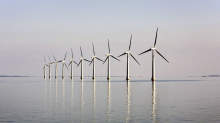Cost Of UK Offshore Wind Projected To Drop One Third By 2020
 A new study released by The Crown Estate and the Offshore Wind Cost Reduction Task Force predicts that the cost of offshore wind generation in the UK will drop by one-third by the year 2020.
A new study released by The Crown Estate and the Offshore Wind Cost Reduction Task Force predicts that the cost of offshore wind generation in the UK will drop by one-third by the year 2020.The Crown Estate licenses offshore wind projects and the Offshore Wind Cost Reduction Task Force is a division of the UK’s Department of energy and Climate Change.
The UK wants the technology to account for as much as one-fifth of total electricity needs — about 18GW by 2020. But because of the high cost of the technology and a lack of transmission infrastructure, the pace of adoption has been modest. The European debt crisis has also stalled development.
The current cost of offshore wind energy in the UK is much higher than the current cost of natural gas. This is one reason the conservative Tory party has shifted focus to gas — to the chagrin of some in the wind industry. Despite this emerging conflict, the government report argues that wind needs to play a crucial role:
“Ours is an island nation, blessed with copious wind and shallow seas. If we are to match our clean energy ambitions, we must take full advantage of this potent natural resource.We believe that the offshore wind industry can and must evolve to be more competitive and forward looking. That in turn will boost the security of our energy supplies, create jobs, and attract further inward investment.”
Europe is already the leader in offshore wind development. According to estimates by the European Wind Energy Association, wind energy could account about 14 percent of Europe’s cumulative electricity demand by 2030. The Association also projects that as many as 170,000 Europeans could be employed in the sector by 2020. The experience of European companies has put the industry on a pathway to continued cost reductions, according to the chief executive of RenewableUK, Maria McCaffery:
“Driving down costs is much more than a mere aspiration – the industry is working closely with key stakeholders such as the Crown Estate to chart the course ahead, laying out action plans which are credible and achievable. This will enable the sector to grow from strength to strength – not only generating low-carbon electricity and giving us a secure supply of energy, but also creating tens of thousands of jobs and revitalizing manufacturing throughout the UK.”
However, there’s a lot to be done in order to realize this dramatic cost drop. According to the new report, achieving these reductions would require ” bigger turbines, greater competition among suppliers, better windfarm design, economies of scale, improved installation methods, (and) the mass production of deep water foundations, (so) the industry (can) prove it can reduce risk to investors.”
As in the United States, political strife is undermining the development and improvement of offshore wind farms in the UK. Concern over inconsistent energy policy and unreliable incentives is slowing investment in the resource, reports the Guardian:
Keith Anderson, chief corporate officer at Scottish Power, said that the prospect of the government meddling and making sudden changes to financial support mechanisms for the industry was in danger of spooking financial backers. ‘[Such changes] could set an unwelcoming precedent for the UK energy sector and potentially have an adverse effect on investor confidence at a critical time for the UK energy industry.”’
According to a Bloomberg New Energy Finance report from last last year, onshore wind energy is on pace to be fully cost competitive with natural gas by 2016. As the BNEF researchers point out, for every doubling of installation in onshore wind, the cost of electricity has fallen 14 percent.
With more experience, offshore wind could follow a similar cost curve. And that means more deployment.
You can return to the main Market News page, or press the Back button on your browser.

